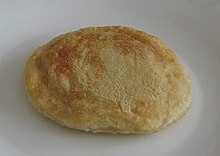Seada
Seada (in Logudorese ) or Sebada (in Campidanese ) - depending on the region also Seata or Sevada - is a typical dish of traditional Sardinian cuisine . The seada is currently seen as a dessert , although originally it could also bethe second main courseas a secondo piatto . The dumplings fried in olive oil are made from semolina , lard , sour cream cheese (in Gallurian Pischedda ; typically young pecorino ) and honey or sugar and possibly grated lemon peel .
Seadas are originally a Spanish dish that has evolved a lot from its origins. The name "Seada" comes from the Sardinian word seu ' tallow ' , an animal fat used to make candles. The origin of the seadas as a cheese-based dish lies in areas of Sardinia that are traditionally associated with pasture farming and are bordered by the four regions of Barbagia , Ogliastra , Logudoro and Gallura . It is now produced all over the island, but its own production still plays a big role, especially in rural areas.
There are different interpretations of the basic recipe, but basically there are two types: with semicotto cheese and baked with raw milk cheese (the latter is called a sa mandrona 'house mother's style' or alla maniera della poltrona 'loafers style' ). For some years now, a “commercial” version has also spread in large retail chains.
Web links
- Seadas or Sebadas: How to make sardinian cheese pastry (English, Italian)
Individual evidence
- ↑ Seadas (traditional Sardinian fritter). In: academiabarilla.com. Academia Barilla, accessed August 11, 2013 .
- ↑ Mario Puddu: Ditzionàriu de sa limba e cultura de sa sarda . 2nd Edition. Edizioni Condaghes, Cagliari 2015, ISBN 978-88-7356-248-1 , keyword sébu, seu (Sardinian).
